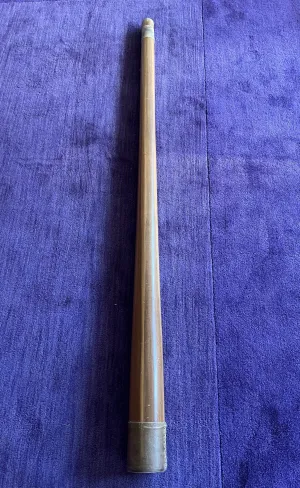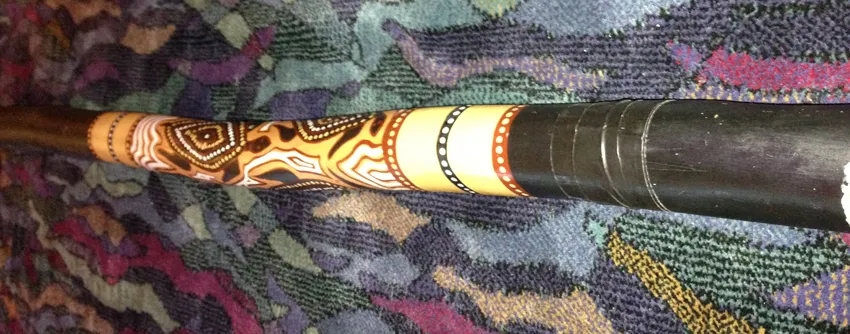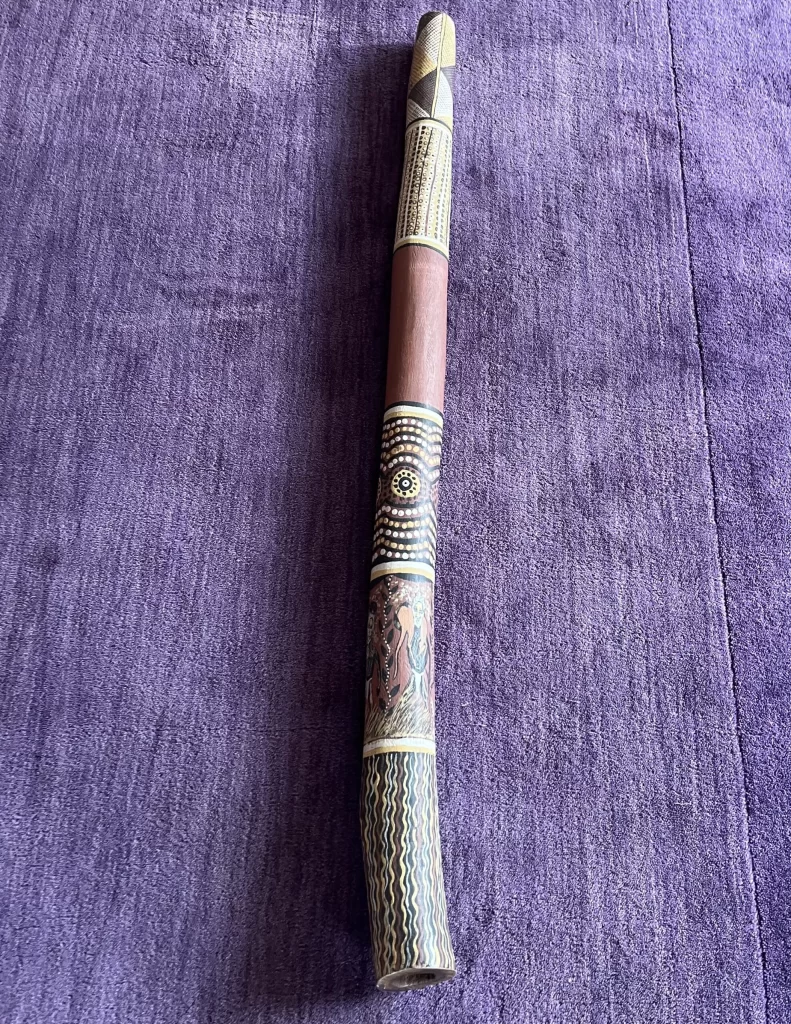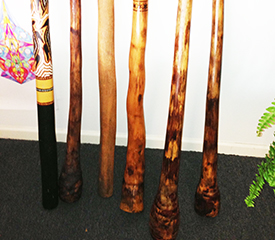Whether you are a beginner seeking an authentic didgeridoo or an experienced player looking for an exquisite piece of Aboriginal art, this guide will help you choose the best didgeridoo to buy.
We have curated a selection of high-quality traditional didgeridoos, each with unique features and characteristics. Let’s explore each authentic didgeridoos for sale, detailing key features, why you should buy it, and what makes it so special.
Best Didgeridoos to Buy | 4 Best Picks
The best didgeridoo to buy are more than just a musical instrument; it is a tool for healing, meditation, and cultural connection. Whether you are an experienced player or just starting, each of these didgeridoos has something special to offer. Explore their unique features, connect with the one that resonates with you, and embark on a journey of music, meditation, and healing.
1. Traditional Aboriginal Didgeridoo from Australia

Key Features
- Material: Eucalyptus Wood: This didgeridoo for sound healing is crafted from traditional Eucalyptus wood, which is widely recognized as the best material for authentic didgeridoos due to its durability and excellent sound quality.
- Origin: Australia: This didgeridoo is sourced directly from Australia, ensuring the authenticity and cultural connection of the instrument.
- Tuning: F#/Gb: Tuned to F#/Gb, this didgeridoo produces a beautiful, clear, and resonant tone that is suitable for various music styles and sound healing purposes.
- Craftsmanship: Aboriginal: Created by Aboriginal artisans, this didgeridoo embodies the traditional craftsmanship that makes it both a cultural artifact and a high-quality aboriginal didgeridoo instrument.
- Price: $450.00: A fair price for authentic, traditional didgeridoos for meditation crafted with traditional materials.
Why Buy It?
This Traditional Aboriginal Didgeridoo from Australia is ideal for anyone seeking an authentic playing experience. Its tuning in F#/Gb offers a versatile tone that is perfect for both beginners and experienced players.
The use of Eucalyptus wood ensures durability, resonance, and a beautiful sound quality. This didgeridoo is also a great choice for those interested in sound healing and vibrational therapy, as its rich tones create a soothing and meditative atmosphere.
Why Do We Love It?
We love this didgeridoo because of its authenticity and rich history. Knowing that it has been crafted by Aboriginal artisans using traditional techniques and materials adds a cultural depth to every note played.
The F#/Gb tuning produces a versatile and melodious sound that works well in many settings, from music performances to meditative practices. It’s a piece that not only serves as a musical instrument but also as a tribute to Aboriginal heritage and craftsmanship.
2. Traditional Didgeridoo from Australia – C#/Db

Key Features
- Material: Eucalyptus Wood: Crafted from high-quality Eucalyptus wood, this didgeridoo ensures excellent sound projection and resonance.
- Origin: Australia: Directly sourced from Australia, maintaining the authenticity of the traditional Aboriginal musical experience.
- Tuning: C#/Db: Tuned to C#/Db, this didgeridoo offers a unique tonal quality that is deep and resonant, making it perfect for sound healing.
- Craftsmanship: Aboriginal: Handcrafted by Aboriginal artisans, ensuring that each didgeridoo is unique and made with care.
- Price: $450.00: A reasonable price for a handcrafted, culturally significant instrument.
Why Buy It?
The Traditional Aboriginal Didgeridoo from Australia tuned to C#/Db is perfect for those seeking a didgeridoo with a distinct and resonant tonal quality. The tuning produces a deep and calming sound that is ideal for meditation, sound healing, and relaxation practices. The fact that it is crafted from Eucalyptus wood makes it a durable and high-quality instrument that will last for years, providing a genuine playing experience that connects you to the roots of Aboriginal culture.
Why Do We Love It?
We love this didgeridoo for its deep, resonant tone that is perfect for therapeutic and meditative purposes. The C#/Db tuning is less common, offering a unique experience for both the player and listeners. The craftsmanship is remarkable, with each didgeridoo being handcrafted by Aboriginal artisans, giving it an element of authenticity and individuality. It’s a fantastic choice for anyone wanting to explore the therapeutic benefits of playing the didgeridoo.
3. Traditional Aboriginal Painted Didgeridoo from Australia

Key Features
- Material: Eucalyptus Wood: Made from traditional Eucalyptus wood, this didgeridoo is durable and produces high-quality sound.
- Hand-Painted: Aboriginal Artwork: This didgeridoo is decorated with beautiful Aboriginal artwork, making it both a musical instrument and a piece of art.
- Origin: Australia: Sourced directly from Australia, ensuring that it remains true to its cultural origins.
- Tuning: G: Tuned to G, this didgeridoo offers a balanced sound that is ideal for music performances and sound healing.
- Mouthpiece: Beeswax Required: Requires a beeswax mouthpiece, which helps in creating a comfortable playing experience and better air sealing.
Why Buy It?
This Traditional Aboriginal Painted Didgeridoo from Australia is a great option for those who not only want a quality musical instrument but also appreciate traditional Aboriginal art. The hand-painted artwork makes this didgeridoo visually stunning, making it a beautiful display piece as well as a playable instrument.
The tuning to G provides a harmonious tone that works well for both solo and group performances. It’s a fantastic addition for those who want to combine the cultural significance of Aboriginal art with the therapeutic sounds of the didgeridoo.
Why Do We Love It?
We love this didgeridoo because it merges art with music. The hand-painted designs are visually captivating, adding an aesthetic element that makes this didgeridoo special. It’s not just an instrument but also a piece of Aboriginal culture that tells a story through both its sound and appearance.
The tuning to G is versatile, producing warm, resonant tones that enhance meditative practices and create a soothing atmosphere. The combination of cultural art and musical functionality makes it a unique and cherished item.
4. Traditional Aboriginal Painted Didgeridoo from Australia – A

Key Features
- Material: Eucalyptus Wood: This didgeridoo is crafted from traditional Eucalyptus wood, known for its excellent sound quality and durability.
- Hand-Painted: Authentic Designs: Features authentic Aboriginal hand-painted designs, adding a visual element of cultural expression.
- Origin: Australia: Directly sourced from Australia, ensuring a genuine Aboriginal musical experience.
- Tuning: A: Tuned to A, this didgeridoo produces a lower and deeper tone, which is ideal for grounding and relaxation.
- Mouthpiece: Beeswax Required: Requires a beeswax mouthpiece, which enhances the playing comfort and air seal.
Why Buy It?
The Traditional Aboriginal Painted Didgeridoo tuned to A is perfect for those looking for a didgeridoo with a deep, grounding tone. The lower tuning makes it ideal for relaxation, sound healing, and grounding practices.
The hand-painted designs add an extra layer of cultural appreciation, making it a beautiful piece for display as well as for playing. The use of Eucalyptus wood ensures that this didgeridoo is not only a great musical instrument but also a durable and long-lasting one.
Why Do We Love It?
We love this didgeridoo because of its deep and resonant tone that creates a powerful grounding effect during meditation and sound healing sessions. The tuning to A offers a rich, bass-like quality that feels almost like a physical vibration, promoting a sense of stability and balance.
The hand-painted artwork is simply stunning, and each design is unique, reflecting the individual style of the Aboriginal artist. It’s a must-have for those who are drawn to the cultural heritage of the didgeridoo and the deep, resonant sounds it can produce.
Buying Guide: Best Didgeridoos to Buy
The best didgeridoo to buy a fascinating and ancient musical instrument that has been used for centuries by the Aboriginal people of Australia. It is more than just an instrument—its powerful vibrations are known to promote healing, relaxation, and meditation.
Whether you’re a beginner or an experienced player looking for a new addition, buying the right didgeridoo can make all the difference in your playing experience and the benefits you receive. This buying guide will walk you through the key factors to consider when purchasing a didgeridoo, helping you make the best decision for your needs.
1. Types of Didgeridoos
Didgeridoos come in various styles, sizes, and tunings. Understanding the differences between them will help you determine which type best fits your needs.
a. Traditional Aboriginal Didgeridoos
Traditional didgeridoos are made from eucalyptus trees that have been naturally hollowed out by termites. They are typically sourced from Northern Australia and crafted by Aboriginal artisans. These didgeridoos are known for their authentic sound quality and cultural significance. Examples include the Traditional Aboriginal Didgeridoo from Australia and Traditional Aboriginal Painted Didgeridoo from Australia.
b. Painted Didgeridoos
Painted didgeridoos are traditional healing didgeridoo music tools adorned with authentic Aboriginal artwork. These didgeridoos serve as both musical instruments and beautiful pieces of cultural art. The hand-painted designs make each didgeridoo unique, adding an element of visual appeal. If you’re interested in a didgeridoo that reflects Aboriginal culture visually, these are a great choice.
c. Modern Didgeridoos
Modern didgeridoos are often made from materials like PVC, bamboo, or fiberglass. They are typically mass-produced and more affordable, making them great for beginners. While they lack the authenticity of traditional eucalyptus didgeridoos, they can still produce a good quality sound and are often more lightweight and durable.
2. Material Considerations
The material used to make a didgeridoo has a significant impact on its sound quality, durability, and overall playing experience. Traditional didgeridoos are made from eucalyptus wood, which is prized for its resonant and warm tone. Eucalyptus didgeridoos are heavier but provide an authentic playing experience. Here’s what to consider when choosing the material:
- Eucalyptus Wood: Known for producing rich, resonant tones with excellent projection. These didgeridoos are heavier but offer the highest quality sound. Examples include the Traditional Aboriginal Didgeridoo from Australia.
- Bamboo: Bamboo didgeridoos are lightweight, affordable, and suitable for beginners. However, they lack the depth and resonance of eucalyptus didgeridoos.
- Synthetic Materials: Modern didgeridoos made from PVC or fiberglass are easy to maintain, more durable, and resistant to environmental changes. They are a great choice for traveling and practicing outdoors.
3. Tuning and Sound Quality
The tuning of the didgeridoo determines its pitch, and each tuning has its unique sound qualities that can be suited to different styles of playing or healing. The didgeridoos featured in our selection have tunings like F#/Gb, C#/Db, G, and A, each offering a unique sound that’s suited for various applications.
- F#/Gb Tuning: This pitch produces a bright and clear sound that is versatile and can be used in different types of music and sound healing. The Traditional Aboriginal Didgeridoo from Australia (F#/Gb) is a great example of a didgeridoo that produces a harmonious tone that works well for performance and therapeutic use.
- C#/Db Tuning: This tuning offers a deeper and more resonant tone, perfect for creating a calming and meditative atmosphere. It is ideal for healing practices and grounding energy work.
- G Tuning: This pitch provides a balanced sound that is both clear and deep, making it suitable for rhythmic playing and dynamic performances. It’s also great for beginners as it offers a versatile range of tones.
- A Tuning: The Traditional Aboriginal Painted Didgeridoo from Australia (A) produces a deep, bass-like sound that is perfect for grounding and creating a sense of stability during meditation or healing sessions.
4. Size and Length
The size and length of a didgeridoo directly impact its pitch, sound quality, and ease of play. The longer the didgeridoo, the deeper the pitch it produces.
- Short Didgeridoos (3-4 feet): These didgeridoos are easier to play and are often tuned to higher pitches. They are more portable and suitable for beginners who are learning to master circular breathing.
- Medium Didgeridoos (4-5 feet): Medium-length didgeridoos offer a good balance between playability and sound depth. They are suitable for most players and can produce a wide range of tones.
- Long Didgeridoos (5-6+ feet): These didgeridoos produce deep, resonant sounds that are ideal for meditation and sound healing. They require more lung capacity to play effectively, making them better suited for experienced players.
5. Decorative vs. Functional Use
If you’re buying a didgeridoo for decorative purposes, consider a painted didgeridoo with beautiful Aboriginal designs. The Traditional Aboriginal Painted Didgeridoo is not only a functional instrument but also a piece of cultural art that can be displayed in your home or studio.
If you’re buying a didgeridoo for functional use, focus on the sound quality, ease of play, and material. Traditional didgeridoos made from eucalyptus wood are the best choice for an authentic experience.
6. Skill Level and Player Experience
Your skill level and experience as a player will determine which didgeridoo is best for you.
a. Beginner Players
For beginners, it’s essential to choose a didgeridoo that is easy to play and requires less lung capacity. Smaller didgeridoos made from lightweight materials like bamboo or PVC are ideal. The Traditional Aboriginal Didgeridoo (C#/Db) is also suitable for beginners who want an authentic experience, as it provides a balanced tone that is easy to work with.
b. Intermediate and Advanced Players
If you have experience playing the didgeridoo and want to explore different tunings and deeper tones, consider a larger didgeridoo made from eucalyptus wood. The Traditional Aboriginal Painted Didgeridoo (A) is the excellent choice for advanced players looking to explore a deeper, more resonant sound.
c. Sound Healers and Meditation Practitioners
For sound healing and meditation, consider a didgeridoo with a deep and resonant tone, such as the Traditional Aboriginal Didgeridoo (F#/Gb). The deeper tones are more effective at promoting relaxation and creating a meditative atmosphere. Painted didgeridoos also add a visual element that can enhance the overall experience for clients and participants.
7. Price Considerations
Didgeridoos can vary significantly in price, depending on the material, craftsmanship, and decorative elements. Traditional eucalyptus didgeridoos are generally more expensive due to the quality of the wood and the craftsmanship involved.
- Affordable Options: Bamboo and synthetic didgeridoos are typically more affordable and great for beginners or casual players.
- Mid-Range Options: Didgeridoos made from eucalyptus wood that are not decorated fall into a mid-range price point and offer an authentic playing experience.
- High-End Options: Hand-painted eucalyptus didgeridoos are more expensive, but they provide both high-quality sound and cultural significance.
The Traditional Aboriginal Didgeridoo from Australia costs around $450.00, which is reasonable for a handcrafted instrument that offers both quality and authenticity.
8. Accessories and Maintenance
a. Mouthpiece
Many didgeridoos, such as the Traditional Aboriginal Painted Didgeridoo, require a beeswax mouthpiece. Beeswax helps create a comfortable seal between your lips and the didgeridoo, making it easier to produce the proper sound. Over time, the beeswax may need to be replaced, so it’s essential to keep some on hand.
b. Care and Maintenance
Proper maintenance of your didgeridoo will ensure that it lasts for many years. Traditional didgeridoos made from eucalyptus wood should be kept in a dry environment to prevent cracking or splitting. If your didgeridoo has a painted finish, be sure to handle it with care to avoid damaging the artwork.
Synthetic didgeridoos require less maintenance but should still be cleaned regularly to ensure optimal sound quality. Always keep your didgeridoo away from extreme temperatures, as this can affect the material and tuning.
How to Play the Didgeridoo: Tips for Beginners
Learning to play the didgeridoo is an exciting and rewarding journey that requires patience, practice, and a few key techniques. If you’re new to the instrument, here are some tips that will help you get started and build a solid foundation for playing the didgeridoo effectively.
a. Mastering the Drone
The primary sound produced by the didgeridoo is called the drone. This is the deep, continuous tone that forms the basis of all didgeridoo playing. To produce the drone, place your lips on the mouthpiece and use a loose “buzzing” motion, similar to blowing a raspberry. The key is to keep your lips relaxed and create a steady stream of air.
Practice buzzing your lips and gradually transition to pressing them against the didgeridoo mouthpiece. It may take some time to create a consistent drone, so don’t get discouraged if it doesn’t happen right away.
b. Circular Breathing
Circular breathing is an essential technique that allows you to play the didgeridoo continuously without pausing for breath. It involves breathing in through your nose while simultaneously using the air stored in your cheeks to maintain the drone.
To learn circular breathing:
- Fill Your Cheeks with Air: Practice puffing your cheeks with air while breathing in and out through your nose.
- Expel Air from Cheeks: Use the muscles of your cheeks to push air out while you continue to inhale through your nose.
- Combine with Drone: Practice this technique on the didgeridoo by buzzing your lips and using the stored air in your cheeks to maintain the drone while you take quick breaths in through your nose.
Circular breathing can be challenging at first, but with regular practice, it becomes second nature. It is the key to producing the hypnotic, continuous sound that the didgeridoo is known for.
c. Adding Rhythms and Variations
Once you are comfortable with the basic drone, you can start incorporating rhythms and vocalizations to add texture and variety to your playing. You can use your voice to create overtones, grunts, or rhythmic accents.
Experiment with different tongue movements and varying the pressure of your lips to create unique sounds and patterns.
Practicing rhythms can also be done by using simple syllables like “ta,” “ka,” and “da” while maintaining the drone. These vocal sounds will add a percussive quality to your playing, making it more dynamic and interesting.
d. Breath Control and Relaxation
Playing the didgeridoo effectively requires good breath control and maintaining a relaxed state. It’s important not to overblow the instrument, as this can lead to tension in the lips and face.
Focus on gentle, controlled breathing and allow your body to relax while playing. Proper breath control will not only help you produce a smoother drone but also make circular breathing more manageable.
If you feel any tension building up, take a break, and practice some deep breathing exercises before resuming. Playing the didgeridoo should be a relaxing and meditative experience, so staying calm and focused is essential.
Conclusion
Choosing the best didgeridoo to buy for your needs can be a rewarding journey, allowing you to explore the unique sounds and cultural heritage of this ancient instrument. Each of the didgeridoos we’ve featured offer something different—whether it’s the rich, resonant tone of the Traditional Aboriginal Didgeridoo from Australia tuned to F#/Gb or the visually captivating Traditional Aboriginal Painted Didgeridoo with its beautiful artwork.
When deciding which didgeridoo is right for you, consider the tone, craftsmanship, and cultural significance of each piece. The Traditional Aboriginal Didgeridoo in C#/Db is an excellent choice for those looking for a deep, meditative tone, while the Painted Didgeridoo options provide both musical quality and artistic value, making them perfect for display as well as playing.


